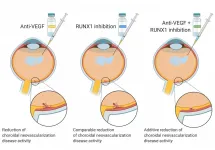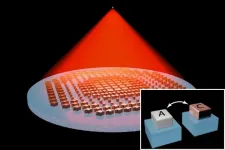INFORMATION:
'Mini brain' organoids grown in lab mature much like infant brains
The stem cell-derived 'brains' follow an internal clock to replicate human brain development
2021-02-22
(Press-News.org) A new study from UCLA and Stanford University researchers finds that three-dimensional human stem cell-derived 'mini brain' organoids can mature in a manner that is strikingly similar to human brain development.
For the new study, published in Nature Neuroscience February 22, senior authors Dr. Daniel Geschwind of UCLA and Dr. Sergiu Pasca of Stanford University conducted extensive genetic analysis of organoids that had been grown for up to 20 months in a lab dish. They found that these 3D organoids follow an internal clock that guides their maturation in sync with the timeline of human development.
"This is novel -- Until now, nobody has grown and characterized these organoids for this amount of time, nor shown they will recapitulate human brain development in a laboratory environment for the most part," said Geschwind, MD, PhD, MacDonald Distinguished Professor in Human Genetics at the David Geffen School of Medicine at UCLA, member of the Eli and Edythe Broad Center of Regenerative Medicine and Stem Cell Research at UCLA, and the senior associate dean and associate vice chancellor and director of the Institute for Precision Health at UCLA.
"This will be an important boost for the field. We've shown that these organoids can mature and replicate many aspects of normal human development -- making them a good model for studying human disease in a dish," he said.
Human brain organoids are created using induced pluripotent stem cells, also known as iPS cells, which are derived from skin or blood cells that have been reprogrammed back to an embryonic stem cell-like state allowing scientists to create any cell type.
These iPS cells are then exposed to a specialized mix of chemicals that influences them to create the cell of a certain region of the brain. With time and the right conditions, the cells self-organize to create 3D structures that faithfully replicate several aspects of human brain development.
Human stem cell-derived organoids have the potential to revolutionize the practice of medicine by giving researchers unprecedented insights into how complex organs - including the brain - develop and respond to disease.
For several years, researchers have been growing human brain organoids to study human neurological and neurodevelopmental disorders, such as epilepsy, autism and schizophrenia.
The utility of these models has been hindered by the widespread belief that the cells that make up these organoids remain stuck in a developmental state analogous to the cells seen in fetal development. The study shows that it may be possible to grow the cells to a maturity that will allow scientists to better study adult-onset diseases, such as schizophrenia or dementia.
"There is huge interest in stem cell models of human disease," Geschwind added. "This work represents an important milestone by showing which aspects of human brain development are modeled with the highest fidelity and which specific genes are behaving well in vitro and when best to model them. Equally important, we provide a framework based on unbiased genomic analyses for assessing how well in vitro models model in vivo development and function."
The authors also provide a tool called GECO that allows researchers to browse their genes of interest for measuring fidelity between in vitro and in vivo brain.
"We show that these 3D brain organoids follow an internal clock, which progresses in a laboratory environment in parallel to what occurs inside a living organism," said first author Aaron Gordon, PhD, a post doc in The Geschwind Lab at the David Geffen School of Medicine at UCLA. "This is a remarkable finding -- we show that they reach post-natal maturity around 280 days in culture, and after that begin to model aspects of the infant brain, including known physiological changes in neurotransmitter signaling."
ELSE PRESS RELEASES FROM THIS DATE:
New dating techniques reveal Australia's oldest known rock painting, and it's a kangaroo
2021-02-22
A two-metre-long painting of a kangaroo in Western Australia's Kimberley region has been identified as Australia's oldest intact rock painting.
Using the radiocarbon dating of 27 mud wasp nests, collected from over and under 16 similar paintings, a University of Melbourne collaboration has put the painting at 17,500 and 17,100 years old.
"This makes the painting Australia's oldest known in-situ painting," said Postdoctoral Researcher Dr Damien Finch who pioneered the exciting new radiocarbon technique.
"This is a significant find as through these initial estimates, we can understand something of the ...
Association of timing of school closings, behavioral changes with evolution of COVID-19 pandemic in US
2021-02-22
What The Study Did: Using COVID-19 data, this observational study looked at what are the independent associations of voluntary behavioral change and legal restrictions, such as state-mandated school closings, with the subsequent spread of the COVID-19 pandemic in the U.S.
Authors: Frederick J. Zimmerman, Ph.D., of the Fielding School of Public Health at UCLA in Los Angeles, is the corresponding author.
To access the embargoed study: Visit our For The Media website at this link https://media.jamanetwork.com/
(doi:10.1001/jamapediatrics.2020.6371)
Editor's Note: The article includes ...
Scientists link star-shredding event to origins of universe's highest-energy particles
2021-02-22
A team of scientists has detected the presence of a high-energy neutrino--a particularly elusive particle--in the wake of a star's destruction as it is consumed by a black hole. This discovery, reported in the journal Nature Astronomy, sheds new light on the origins of Ultrahigh Energy Cosmic Rays--the highest energy particles in the Universe.
The work, which included researchers from more than two dozen institutions, including New York University and Germany's DESY research center, focused on neutrinos--subatomic particles that are produced on Earth only in powerful ...
Trauma admissions during COVID-19 pandemic in LA county
2021-02-22
What The Study Did: Researchers examined changes in trauma admissions throughout Los Angeles County during the COVID-19 pandemic in California.
Authors: Kazuhide Matsushima, M.D., of the University of Southern California in Los Angeles, is the corresponding author.
To access the embargoed study: Visit our For The Media website at this link https://media.jamanetwork.com/
(doi:10.1001/jamanetworkopen.2021.1320)
Editor's Note: The article includes funding/support disclosures. Please see the article for additional information, including other authors, author contributions and affiliations, conflict of interest and financial disclosures, ...
New technique reveals switches in RNA
2021-02-22
Scientists at the University of Groningen (The Netherlands), in collaboration with colleagues from the University of Torino (Italy), have developed a method to visualize and quantify alternative structures of RNA molecules. These alternative RNA 'shapes' can have important functional relevance in viruses and bacteria. The researchers used an algorithm to rapidly analyse large quantities of chemically modified RNA molecules and calculate how many differently folded conformations were present. This technique was used to identify a conserved structural switch in the ...
Patient page: Teen vaping
2021-02-22
What The Article Says: How parents can identify whether their teens are vaping, how to help prevent it, and what to do if their teen is addicted are discussed in this JAMA Pediatrics Patient Page.
To access the embargoed study: Visit our For The Media website at this link https://media.jamanetwork.com/
(doi:10.1001/jamapediatrics.2020.6689)
Editor's Note: Please see the article for additional information, including other authors, author contributions and affiliations, conflict of interest and financial disclosures, and funding and support.
INFORMATION:
Media advisory: The full article is linked to this news release.
Embed this link to provide your readers free access to the full-text article This link will be live at the embargo time https://jamanetwork.com/journals/jamapediatrics/fullarticle/10.1001/jamapediatrics.2020.6689?guestAccessKey=8fe3a04c-4e0a-40f3-a883-916eaadb05bb&utm_source=For_The_Media&utm_medium=referral&utm_campaign=ftm_links&utm_content=tfl&utm_term=022221
...
State legislation related to abortion services
2021-02-22
What The Study Did: This survey study looked at changes in abortion policies among states by examining legislation enacted between January 2017 and November 2020.
Authors: Phillip M. Singer, Ph.D., of the University of Utah in Salt Lake City, is the corresponding author.
To access the embargoed study: Visit our For The Media website at this link https://media.jamanetwork.com/
(doi:10.1001/jamainternmed.2020.8781)
Editor's Note: Please see the article for additional information, including other authors, author contributions and affiliations, conflict of interest and financial disclosures, and funding ...
Genomic insights into the origin of pre-historic populations in East Asia
2021-02-22
Diverse East Asians derive ancestry from a coastal expansion tens of thousands of years ago
Researchers have long debated whether the peopling of East Asia by modern humans occurred mainly via a coastal or interior route. The answer is probably both. "Indigenous Andaman islanders of the Bay of Bengal, Indigenous Tibetans, ancient Taiwanese, and ancient and modern Japanese all derive ancestry from a deep shared lineage that split from other East Asian lineages more than 40,000 years ago," says David Reich, co-senior author of the study, who is a Professor of Genetics ...
New therapeutic approach may help treat age-related macular degeneration effectively
2021-02-22
Philadelphia, February 22, 2021 - Runt-related transcription factor 1 (RUNX1) has been linked to retinal neovascularization and the development of abnormal blood vessels, which result in vision loss in diabetic retinopathy. Now, scientists have found that RUNX1 inhibition presents a new therapeutic approach in the treatment of age-related macular degeneration (AMD), which is the leading cause of blindness in the elderly worldwide. Their END ...
New "metalens" shifts focus without tilting or moving
2021-02-22
Polished glass has been at the center of imaging systems for centuries. Their precise curvature enables lenses to focus light and produce sharp images, whether the object in view is a single cell, the page of a book, or a far-off galaxy.
Changing focus to see clearly at all these scales typically requires physically moving a lens, by tilting, sliding, or otherwise shifting the lens, usually with the help of mechanical parts that add to the bulk of microscopes and telescopes.
Now MIT engineers have fabricated a tunable "metalens" that can focus on objects at multiple depths, without changes to its physical position or shape. The lens is made not of solid glass but of a ...
LAST 30 PRESS RELEASES:
Injectable breast ‘implant’ offers alternative to traditional surgeries
Neuroscientists devise formulas to measure multilingualism
New prostate cancer trial seeks to reduce toxicity without sacrificing efficacy
Geometry shapes life
A CRISPR screen reveals many previously unrecognized genes required for brain development and a new neurodevelopmental disorder
Hot flush treatment has anti-breast cancer activity, study finds
Securing AI systems against growing cybersecurity threats
Longest observation of an active solar region
Why nail-biting, procrastination and other self-sabotaging behaviors are rooted in survival instincts
Regional variations in mechanical properties of porcine leptomeninges
Artificial empathy in therapy and healthcare: advancements in interpersonal interaction technologies
Why some brains switch gears more efficiently than others
UVA’s Jundong Li wins ICDM’S 2025 Tao Li Award for data mining, machine learning
UVA’s low-power, high-performance computer power player Mircea Stan earns National Academy of Inventors fellowship
Not playing by the rules: USU researcher explores filamentous algae dynamics in rivers
Do our body clocks influence our risk of dementia?
Anthropologists offer new evidence of bipedalism in long-debated fossil discovery
Safer receipt paper from wood
Dosage-sensitive genes suggest no whole-genome duplications in ancestral angiosperm
First ancient human herpesvirus genomes document their deep history with humans
Why Some Bacteria Survive Antibiotics and How to Stop Them - New study reveals that bacteria can survive antibiotic treatment through two fundamentally different “shutdown modes”
UCLA study links scar healing to dangerous placenta condition
CHANGE-seq-BE finds off-target changes in the genome from base editors
The Journal of Nuclear Medicine Ahead-of-Print Tip Sheet: January 2, 2026
Delayed or absent first dose of measles, mumps, and rubella vaccination
Trends in US preterm birth rates by household income and race and ethnicity
Study identifies potential biomarker linked to progression and brain inflammation in multiple sclerosis
Many mothers in Norway do not show up for postnatal check-ups
Researchers want to find out why quick clay is so unstable
Superradiant spins show teamwork at the quantum scale
[Press-News.org] 'Mini brain' organoids grown in lab mature much like infant brainsThe stem cell-derived 'brains' follow an internal clock to replicate human brain development




